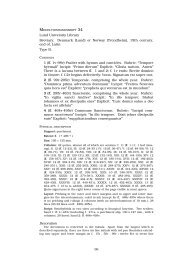Lund University Library Olim - St. Laurentius Digital Manuscript Library
Lund University Library Olim - St. Laurentius Digital Manuscript Library
Lund University Library Olim - St. Laurentius Digital Manuscript Library
Create successful ePaper yourself
Turn your PDF publications into a flip-book with our unique Google optimized e-Paper software.
22 Medieval <strong>Manuscript</strong> Catalogue Mh 6<br />
Thott 21). The somewhat archaic appearance of the script, in the tradition of late<br />
salian minuscule, is datable to c. 1100 and can hardly be considered contemporary<br />
with the clearly romanesque character of the initial. Atentative interpretation<br />
of this, here presumed, discrepancy indicates that the initial is likely to have been<br />
executed when the preface to the Aachen rule was added on. f. 58r , probably<br />
shortly before 1123. Whereas the script is comparable to some of the hands in<br />
Trier, Dombibl. Ms. 138 and 139, made in Helmarshausen c. 1100, the initial is<br />
closer to Trier, Dombibl. Ms. 62, dating from the middle of the 12th century. The<br />
initials in Trier, Ms. 62 are rather more developed than Medeltidshandskrift 6<br />
though, and certain aspects such as the lion repeating the posture of f. 54v in<br />
Trier, Ms. 139, point to a middle position in the development.<br />
Iconography: The two-headed dragon in the white-vine foliage of the first initial<br />
is a common motif, not to be specifically related to the following text. In some<br />
cases texts by Basilius have been illustrated as a pun with a basilisc. Despite the<br />
fact that the dragon in Medeltidshandskrift 6 is two-headed, there is no trace of a<br />
cockscomb, defining the animal as a basilisc. The dragon in connection with the<br />
vine and grapes, is to be interpreted as the snake (cfr. the greek "drakon") in the<br />
garden of Eden. The eagle and lion on f. 58v , interpreted by Wrangel (p. 87) as<br />
evangelist symbols, are more probably allegorical representations in general, illustrating<br />
aspects of Christ conquering the snake, weakened by the knot.<br />
Binding<br />
Blind-tooled brown goatskin binding, Denmark, <strong>Lund</strong> most likely 15th century;<br />
restored back and title gilding 19th century. Size: 248 x 165 x 70 mm.<br />
Brown goatskin binding over square edged oak boards. The covering is worn<br />
and partly cracked at the joints and with a 19th century recovering of the back.<br />
Two metal hook-clasp fastenings at fore-edge, one catch plate of the upper cover<br />
and straps missing. Metal guards at fore-edge corners, one guard missing at the<br />
upper corner of the upper cover. Flat spine. Tight back with four double raised<br />
bands. A gilt title in second compartment, new, and a blind-tooled library paper<br />
label in third compartment of the back. Trimmed edges, no square at fore-edge.<br />
Parchment pastedowns; on front pastedown there are several notes on the contents<br />
of the manuscript and two former shef marks (cfr. above). All along sewing on four<br />
double cords laced through the boards. The cords of the lower board cracked at<br />
the joint. The first and tenth quire of the textblock has repaired 20th century<br />
sewing.<br />
The covers are blind-tooled to a triple line fillets frame with a saltire inside. The<br />
manuscript is kept in a drop front box of parchment and paper.<br />
Foliation<br />
Foliated in pencil by modern cataloguer in upper right corner.<br />
Additions<br />
On ff. 83r-89v ; 176v-177r there are marginal notes in the hand of August<br />
Palm, librarian at the <strong>University</strong> <strong>Library</strong> 1856-1907.<br />
On f. 183r there is a note in a 16th century hand: Wii Hans mz gudz nade Danmarkes<br />
repeated on f. 183v , where there is also probationes pennae and a note in<br />
acontemporary but different hand: Liber ecclesie metropolitane lundensis quem<br />
ego georgius presbiter canonicus eiusdem ha .<br />
HISTORY<br />
Origin<br />
The manuscript belonged to the Cathedral in <strong>Lund</strong> and was drawn up in 1123<br />
for the inauguration of the main altar of the crypt. It was in continuous use until<br />
1145 when, in conjuntion with the inauguration of the high altar in the choir of the<br />
upper church, it was succeeded by a new record book: Medeltidshandskrift 7, the<br />
so called Liber daticus vetustior. Notes were being copied though from the Liber<br />
daticus into the Necrologium (last datable note is from Oct. 1316) but there are<br />
also occasional notes from as late as early 16th century.














